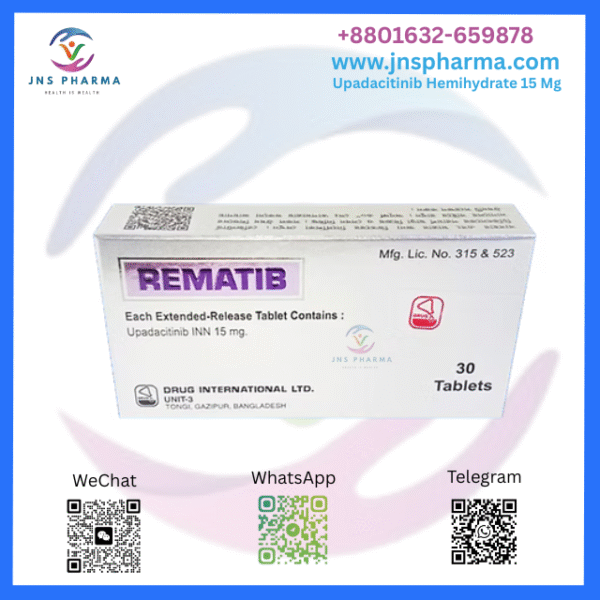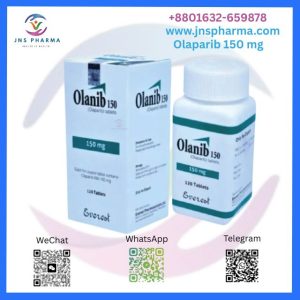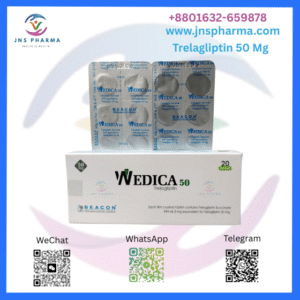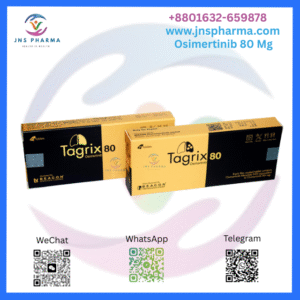Don't miss our holiday offer - up to 50% OFF!
Rematib/Upadacitinib Hemihydrate 15 Mg
Rematib 15 mg is composed of the active medicine Upadacitinib Hemihydrate, a picky Janus kinase( JAK) asset used primarily in the operation of autoimmune and seditious diseases. Upadacitinib is a type of drug classified as targeted synthetic complaint- modifying antirheumatic medicines (tsDMARDs). Upadacitinib has been largely praised for its efficacity in managing conditions like rheumatoid arthritis( RA), psoriatic arthritis, and ulcerative colitis when the usual treatments aren’t effective.
Mechanism of Action
Upadacitinib widely blocks Janus kinase 1( JAK1), a protein that’s pivotal forpro-inflammatory cytokine signaling pathways. By blocking JAK1, Upadacitinib interferes with the signaling of cytokines similar as interleukins and interferons that drive the seditious response of the vulnerable system. similar leaguer results in reduced inflammation, reduced common destruction, and clinical symptom relief of autoimmune conditions.
Compared to thenon-selective JAK impediments, Upadacitinib is more picky against JAK1, and it’s believed that this yields a better safety profile by minimizing those adverse effects caused by JAK2 and JAK3 inhibition.
Indications
Rematib 15 mg is indicated in several seditious conditions. Rematib is typically specified when cases comenon-responders to one or further conventional complaint- modifying antirheumatic medicines( DMARDs). Common approved suggestions are
Moderate to severe adult rheumatoid arthritis( RA)
Psoriatic arthritis
Ankylosing spondylitis
Atopic dermatitis
Ulcerative colitis
Crohn’s disease (off-marker or investigative use in certain countries)
Dosage and Administration
The typical dose of Rematib is 15 mg formerly daily taken orally, with or without food. In conditions similar as ulcerative colitis, advanced boluses( e.g., 30 mg/ day) may be initiated under medical guidance. The smallest effective dose should still be employed to reduce implicit side effects, especially when used for long- term remedy.
Tablets should not be broken up or chewed; they should be eaten whole.
Pharmacokinetics
immersion unforeseen immersion, with peak tube situations of about 1- 2 hours post oral administration.
Bioavailability About 70- 80, with little effect from food.
Half- life About 9 – 14 hours, allowing formerly- diurnal administration.
Metabolism primarily metabolized in the liver by CYP3A4, with negligible CYP2D6 participation.
Elimination is primarily excluded through feces and urine.
Benefits and Effectiveness
Clinical trials have established that Upadacitinib decreases symptoms of autoimmune conditions similar as common pain, swelling, stiffness, and fatigue by a significant quantum. Benefits include
Quick relief from symptoms, with enhancement in some cases within a week
Advanced quality of life and physical functioning
Over time, joint corrosion and structural degeneration are decreased when complaint exertion scores (DAS28, PASI, and Mayo score per complaint) are decreased.
Its oral form also makes it a less complicated choice for cases who refuse to take injectable biologics.
Side Effects and Precautions
Like all potent immunomodulatory specifics, Upadacitinib has side effects, and they may be mild or severe. Mild side effects are
Upper respiratory tract infections
Nausea and abdominal discomfort
pustules
Increased liver enzymes
Headache
Severe side effects that bear immediate medical help
Severe infections like tuberculosis( TB), herpes zoster, and fungal conditions
Blood clots, especially in those with advanced threat
threat improvement of certain cancers, e.g., carcinoma
Changes in the blood, e.g., neutropenia and anemia
Liver injury or elevated transaminases
Gastrointestinal perforation( rare)
Monitoring and Safety Measures
Before treatment with Rematib
Webbing for TB, hepatitis B, and C.
Tests for liver function, complete blood counts, and lipid profile must be carried out.
During treatment
Monitoring of regular blood counts, liver enzymes, and lipids is recommended.
They should report incontinently any suggestion of infection, abnormal bruising, or pain in the tummy.
Contraindications and Interactions
Rematib should be used carefully or not at all in specific situations.
Active serious infections
Severe impairment of the liver
History of thromboembolic events
Drug interactions:
Strong impediments of CYP3A4( e.g., ketoconazole) may raise the tube attention of Upadacitinib.
CYP3A4 corrupters (e.g., rifampin) may reduce its effect.
Consult a healthcare provider before giving other immunosuppressants, vaccines, or anticoagulants.
Use in Special Populations
Gestation Limited data; reserve for use when benefits exceed pitfalls. Beast data suggest implicit fetal detriment.
Lactation Unknown whether Upadacitinib is buried in milk. Breastfeeding should be avoided during remedy.
Pediatrics Use in children isn’t generally approved, except for specific suggestions like atopic dermatitis in aged teens.
Geriatrics Elderly cases are presumably at increased threat for side effects, especially infections and thromboembolic events.
Storage and Handling
Store between 20 °C to 25 °C at room temperature.
Down from heat, direct sun, and humidity.
Not to be left within reach of children.
Conclusion
Rematib 15 mg (Upadacitinib Hemihydrate) is a effective medicine in autoimmune and seditious conditions. Its medium of selectivity, oral administration, and efficacity in cases of contrariness are reasons why it’s a alternate- line choice when first- line treatments fail. Still, close monitoring, webbing, and adherence to safety protocols should be guaranteed while on it to have the maximum benefit with least peril.
As with all successful immunosuppressive remedy, a case-specific approach with importing of pros and cons is needed. Patients are always instructed to speak with their doctor before starting or stopping this drug.







Reviews
There are no reviews yet.